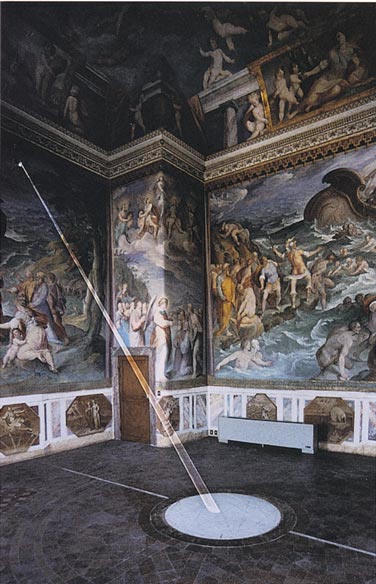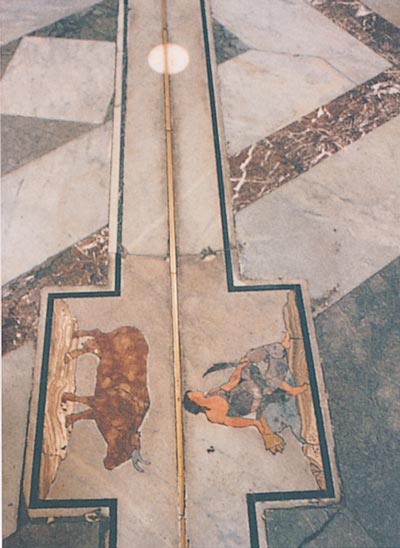
This Article From Issue
May-June 2000
Volume 88, Number 3
DOI: 10.1511/2000.23.0
The Sun in the Church: Cathedrals as Solar Observatories. J. H. Heilbron. ix + 366 pp. Harvard University Press, 1999. $35.
In one of the least-studied chapters in the history of a much-studied period, we learn that, beginning in the mid-15th century, several Italian cathedrals were slightly modified for the sake of science. A well-placed hole in the roof and a carefully aligned meridian bar embedded in the pavement produced a simple but surprisingly powerful instrument for measuring various parameters of the sun's motion. The initial motivation for such solar observatories was the reform of the Catholic calendar. In particular, tracing the movement of the sun's image along the meridian could establish the precise time of the vernal equinox, the principal astronomical event required in the calculation of Easter. Centuries of accumulated error in the Julian calendar and the hodgepodge of methods used in the computus had produced discrepancies between predicted and actual equinox that ranged from a few days to several weeks—an intolerable situation for a "universalist" church that insisted that all of it communicants celebrate its holiest of holy days at the same time. Thus the challenge of the new cathedral-based computus was coincident with the central empirical thrust of the new science—the quantification of experience through systematic, instrument-assisted observation.

From The Sun in the Church
Certain elements critical to the accuracy of cathedral-observatories were architectural givens: structural stability of the "instrument," long distances between roofs and naves and darkened, quiet interiors. The remaining elements—exact measurement of the hole-to-bar distance, exact north-south orientation of the meridian, leveling of the bar, and measurements of the position and diameter of the solar image itself—were matters of mathematical and astronomical expertise. That expertise developed mostly among Catholic clerics and often among members of the Society of Jesus. By the middle of the 17th century, cathedral-observatories in Florence, Bologna, Rome and Palermo were producing the most accurate solar data yet obtained. Only in the mid-18th century, after 150 years of intensive refinement, did the accuracy of telescopic observations eclipse (so to speak) that of naked-eye observations.
Historians of the scientific revolution have rarely viewed calendar reform as the stuff of high drama. When compared to the creation of the grand theories of Copernicus or Newton, the intellectual heroism of Galileo and the "overthrow" of the geocentric world system, the history of the computi would seem to fall under the category of "footnote." Heilbron's richly illustrated, profoundly learned and delightfully witty telling of the tale, however, has transformed that footnote into one of the most revealing episodes in early modern science. The early sections of the book review the background developments of calendar reform (Julian to Gregorian), religious reform (Protestant and Catholic) and scientific reform (Copernicus to Newton). With clarity and economy, the author also lays out the background knowledge in astronomy and spherical geometry the reader will need to follow the technical parts of his argument. (One actually learns some science here.)
Displaying an easy familiarity with an astonishing array of primary and secondary sources, Heilbron weaves into the main story line subplots of contending egos and ideas, civic pride, aristocratic patronage and the Catholic Church's endeavors to retain cultural prestige and scientific authority in the wake of the trial of Galileo. His sensitivity to the cultural climate in which cathedral-observatories arose and operated leads him to several conclusions that many readers may find startling.

From The Sun in the Church
He brings additional—and indeed compelling—evidence to a claim he has made before regarding the Catholic Church as the single biggest patron of scientific activity in the early modern period. His most original claim is that the strongest piece of empirical evidence in favor of the heliocentric theory came not from telescopic observations made by Galileo but from naked-eye observations made in the mid-17th century by Riccioli and Grimaldi, both Jesuits, and their famous student Giovanni Domenico Cassini. Their cathedral-based measurements of the diameter of the sun's image at apogee and perigee ruled in favor of Kepler and unequivocally against Ptolemy.
Moreover, despite the prohibitions against Copernican theory in 1616 and the forced recantation of Galileo in 1633, Catholic astronomers (again principally Jesuits) understood, taught and often used in their astronomical research the heliocentric systems of Copernicus and Kepler. And, despite the great to-do that historians of the scientific revolution have made of the destruction of the Aristotelian geocentric world view and the triumph of the Copernican (or Keplerian) heliocentric world view, a number of important research programs in 17th- and 18th-century observational astronomy did not at all depend on one's worldview—practices, in other words, could often be indifferent to theory.
Finally, with regard to the much-belabored question of the relationship between science and religion, Heilbron argues that the "conflict thesis," which assumes a fundamental and inevitable antagonism between the authority of a dogma-bound church and the free inquiry of scientific research, "simply cannot be sustained." When one looks— and Heilbron has looked more closely and thoroughly than anyone else—one finds not only the sun but also a good bit of science in the church.—Steven J. Harris, Jesuit Institute, Boston College
American Scientist Comments and Discussion
To discuss our articles or comment on them, please share them and tag American Scientist on social media platforms. Here are links to our profiles on Twitter, Facebook, and LinkedIn.
If we re-share your post, we will moderate comments/discussion following our comments policy.